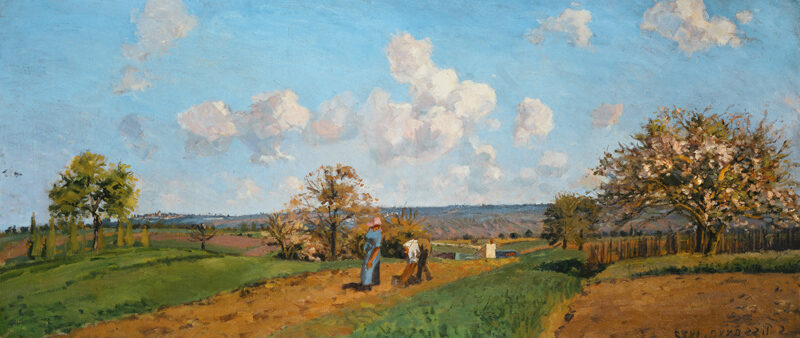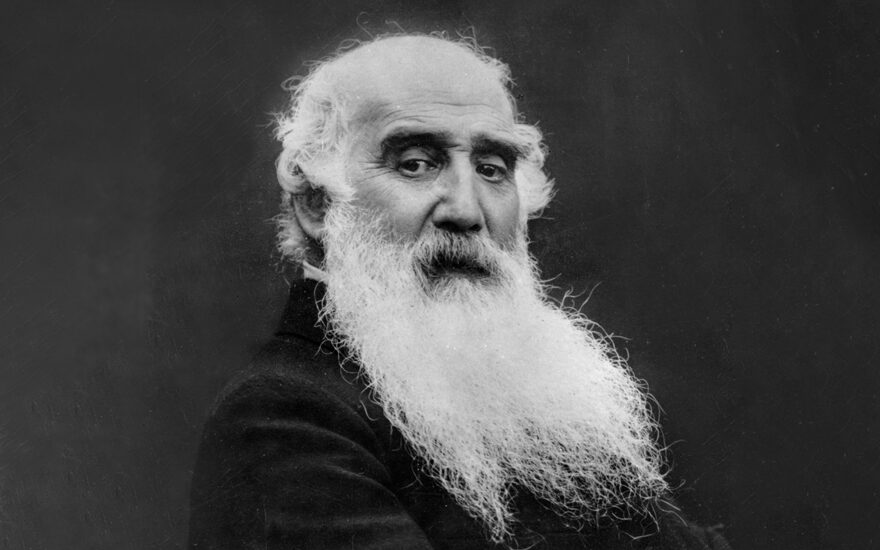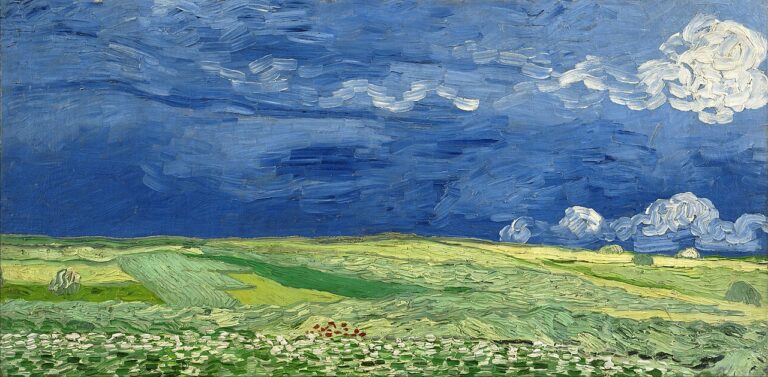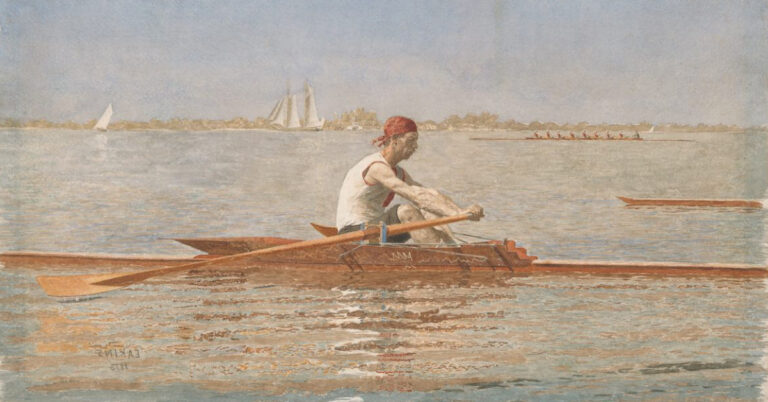Camille Pissarro Painter: The Pioneering Impressionist of 19th Century France
Born: 10 July 1830, Saint Thomas, Danish West Indies
Death: 13 November 1903, Paris, France
Art Movement: Impressionism, Post-Impressionism
Nationality: Danish-French
Teachers: Fritz Melbye and James Gay Sawkins
Institution: École des Beaux-Arts and Académie Suisse
Camille Pissarro Painter: The Pioneering Impressionist of 19th Century France
Life and Work of Camille Pissarro
Camille Pissarro stands as a central figure in the development of Impressionism. He is known for his dedication to capturing light and rural life. His artistic journey spans decades of innovation and collaboration with other notable artists of his time.
Early Years and Inspiration
Born on July 10, 1830, in St. Thomas (then part of the Danish West Indies), Pissarro developed an early interest in art. His parents sent him to Paris for education at age 12, where he first encountered the vibrant art scene.
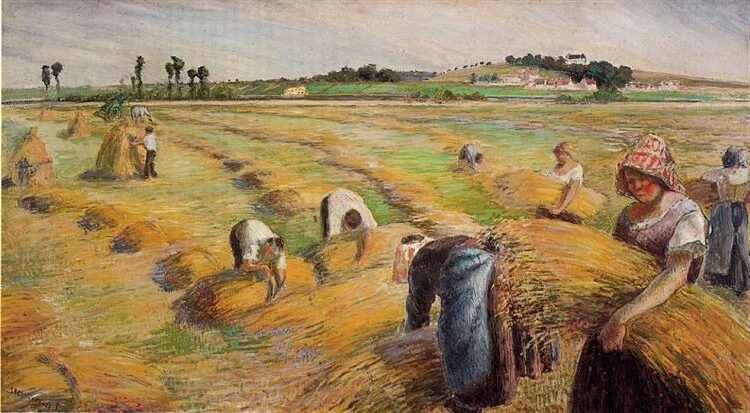
The Harvest (1882) by Camille Pissarro
After returning briefly to St. Thomas, Pissarro permanently moved to France in 1855. There, he studied under established artists and was particularly influenced by Gustave Courbet‘s realism and direct approach to nature.
Pissarro’s early works focused on rural landscapes and peasant life, themes that would remain important throughout his career. He painted outdoors, carefully observing natural light and its effects on color—a practice that later became fundamental to Impressionism.
During these formative years, Pissarro developed his distinctive style by combining careful observation with an increasingly loose brushwork technique.
Pissarro’s Role in Impressionism
Pissarro holds the distinction of being the only artist to exhibit in all eight Impressionist exhibitions from 1874 to 1886. This fact underscores his commitment to the movement and his central role in its development.
Initially, Pissarro struggled for recognition. His submissions to the official Salon were often rejected, pushing him and fellow artists to organize independent exhibitions that would eventually define Impressionism.
During the Franco-Prussian War (1870-1871), Pissarro fled to London, where nearly all his earlier works were destroyed by German soldiers. This devastating loss forced him to essentially restart his career.
Paul Durand-Ruel, an influential art dealer, became a crucial supporter of Pissarro’s work. This relationship helped secure Pissarro’s financial stability and promoted Impressionist art to a wider audience.
Influence and Collaborations
Pissarro acted as a mentor to many younger artists, earning him the nickname “Father Pissarro.” His collaborative approach and willingness to share ideas made him a respected figure among his peers.

Two Women Chatting by the Sea, St. Thomas (1856) – Camille Pissarro
He worked closely with Claude Monet, developing techniques for capturing atmospheric effects and changing light. Their artistic exchanges helped refine the Impressionist approach to color and composition.
In the 1880s, Pissarro briefly experimented with Pointillism alongside Georges Seurat and Paul Signac. This period demonstrated his openness to new artistic methods, though he eventually returned to his more characteristic style.
His teaching significantly influenced artists like Paul Cézanne and Paul Gauguin, who both credited Pissarro with shaping their artistic development. This mentorship role extended his impact beyond his own paintings.
Later Years and Legacy
In his final decades, Pissarro suffered from a chronic eye infection that limited his ability to work outdoors. He adapted by painting city scenes from windows, creating remarkable series of Paris streets from different perspectives.
Despite health challenges, these later urban works represent some of his most accomplished paintings. They captured the modernizing Paris with sensitivity to atmosphere, light, and human activity.
By the time of his death in 1903, Pissarro had finally achieved critical recognition and financial stability. His persistence through decades of artistic development established him as a pivotal figure in art history.
Today, his works hang in major museums worldwide. Art historians recognize Pissarro not only for his technical contributions to Impressionism but also for his role in nurturing the movement and its artists through collaboration and mentorship.
Artistic Style and Techniques
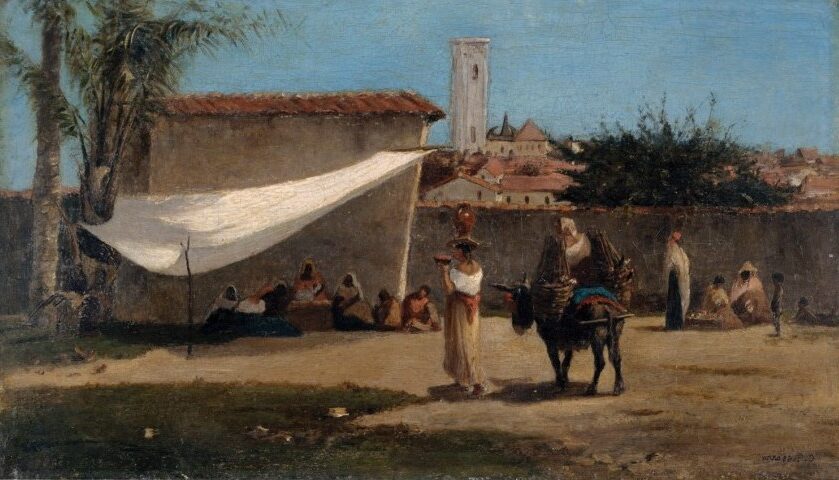
A Plaza in Caracas (c. 1850–52) – Camille Pissarro
Camille Pissarro developed a distinctive artistic approach that evolved throughout his career. His work embodied core Impressionist principles while also exploring other techniques that helped shape modern art movements.
Development of Impressionist Techniques
Pissarro was fundamental to the development of Impressionist techniques in the 1870s. He embraced painting en plein air (outdoors), capturing the changing effects of light and atmosphere directly on canvas. His brushwork became increasingly loose and expressive during this period.
Unlike academic painters who worked in studios, Pissarro preferred to paint outdoors in natural light. This approach allowed him to record authentic color relationships and shifting light conditions.
In his mature Impressionist style, Pissarro used short, visible brushstrokes to create vibrant surfaces. He often applied pure colors side by side rather than mixing them on his palette, allowing the viewer’s eye to blend them optically.
His time in Louveciennes and Pontoise produced some of his most characteristic Impressionist landscapes. These paintings feature a lighter palette than his earlier works and demonstrate his growing mastery of atmospheric effects.
Pointillism and Neo-Impressionism
In the 1880s, Pissarro briefly adopted Pointillism, a Neo-Impressionist technique developed by Georges Seurat. This method involved applying small, distinct dots of pure color that blend visually when viewed from a distance.
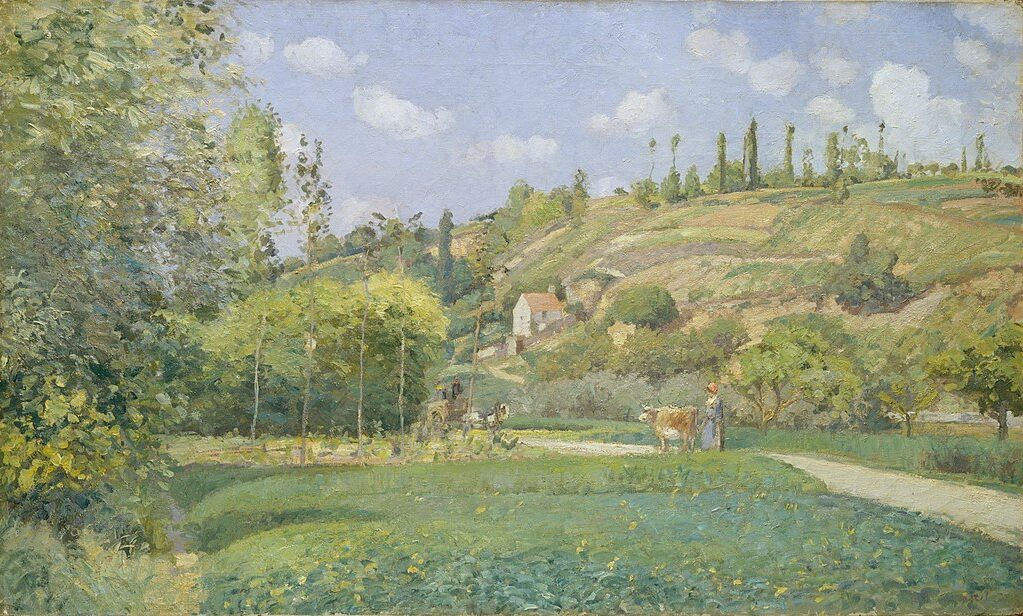
A Cowherd at Valhermeil, Auvers-sur-Oise (1874) – Camille Pissarro
Pissarro was the only established Impressionist to experiment significantly with this scientific approach to color. He used tiny brushstrokes of complementary colors to create vibrant visual effects and luminosity.
His Neo-Impressionist works are characterized by meticulous dot applications and a more structured compositional approach. These paintings often appear more formal and less spontaneous than his earlier works.
By 1890, Pissarro abandoned strict Divisionism, finding its limitations too restrictive. He returned to a freer style but retained some Neo-Impressionist techniques, creating a unique hybrid approach in his later works.
Depiction of Rural and Urban Landscapes
Pissarro skillfully portrayed both rural and urban environments throughout his career. His rural scenes often featured peasants working in fields, orchards, and gardens, showing his deep connection to agricultural life.
Unlike some contemporaries, Pissarro depicted rural laborers with dignity and authenticity. His landscapes weren’t merely scenic views but thoughtful portrayals of human interaction with nature.
In the 1890s, Pissarro turned increasingly toward urban subjects. His series of Boulevard Montmartre paintings captured Paris from elevated viewpoints, showing bustling city life with remarkable atmospheric effects.
His urban scenes in Paris, Rouen, Le Havre, and Dieppe demonstrated his ability to apply Impressionist techniques to city environments. He portrayed the modern urban experience with the same sensitivity he had shown to rural settings.
Weather conditions fascinated Pissarro. He often painted the same scene repeatedly under different light, seasons, and weather, creating series that documented subtle environmental changes.
Impact and Influence on Art
Camille Pissarro shaped art history through his innovative techniques and mentorship of younger artists. His commitment to painting outdoor scenes with attention to light and atmosphere helped define the Impressionist movement.
Legacy in Impressionist Movement
Pissarro was a founding member of the Impressionist movement and the only artist to exhibit in all eight Impressionist Exhibitions from 1874 to 1886. His consistency and dedication earned him the nickname “Father of Impressionism.” Pissarro helped establish the movement’s core principles of painting outdoors (en plein air) and capturing changing light effects.
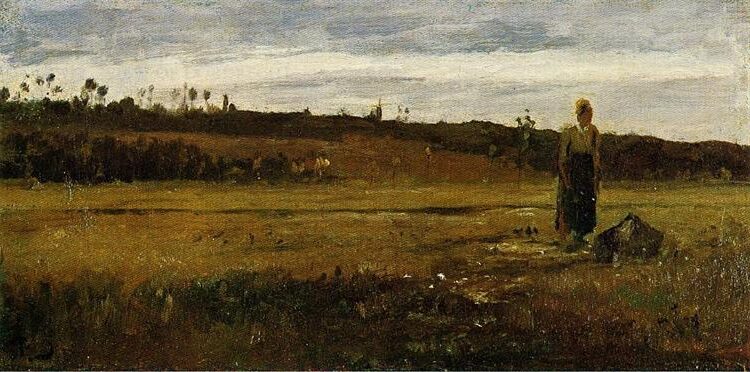
Landscape at Le Varenne Saint Hilaire (c.1865) – Camille Pissarro
His landscapes of rural scenes and cultivated fields showcased his belief in directly observing nature. While artists like Monet focused on dramatic effects, Pissarro often painted quieter moments with equal attention to atmospheric conditions.
The collaborative spirit he fostered at these exhibitions helped legitimize Impressionism against harsh criticism from traditional art institutions.
Relationship with Contemporary Artists
Pissarro maintained important relationships with many key artists of his time. He became a mentor to Paul Cézanne, helping the difficult artist develop his technique during their painting sessions in Pontoise. Their friendship lasted decades despite Cézanne’s challenging personality.
He also worked closely with Monet in developing core Impressionist techniques. Their exchanges strengthened both artists’ approaches to capturing light and color.
Pissarro influenced younger painters like Gauguin and Vincent van Gogh. Gauguin briefly studied under Pissarro before developing his own style. Van Gogh admired Pissarro’s rural scenes and use of color, which informed his own evolving technique.
Contribution to French Art and Beyond
Pissarro’s work bridged multiple artistic movements in French art. He began with Barbizon-influenced realistic landscapes before helping create Impressionism. Later, he briefly explored Pointillism before returning to a more personal Impressionist style.
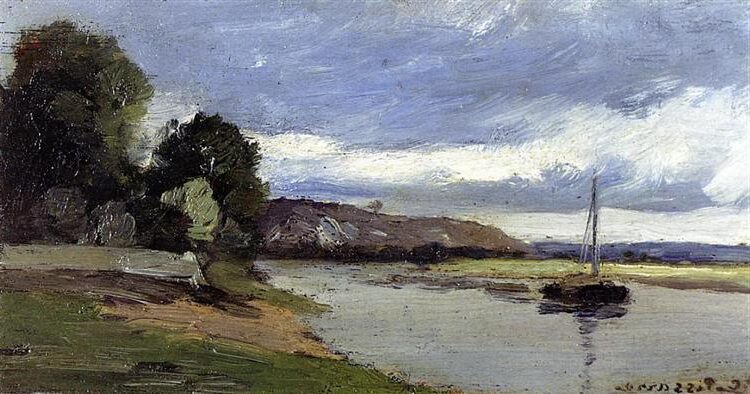
Banks of a River with Barge (c.1864) by Camille Pissarro
His urban scenes of Paris, particularly views of Montmartre and the boulevards, documented a changing France during rapid industrialization. These cityscapes captured everyday life with remarkable honesty.
Pissarro’s influence extended beyond France. His experimental approach to composition and color inspired Neo-Impressionists and Post-Impressionists. His rural scenes from places like Montfoucault influenced how later artists portrayed the countryside.
His teaching methods emphasized observation and individual expression rather than rigid academic rules, helping shape modern approaches to art education.
Frequently Asked Questions
Camille Pissarro left a lasting mark on art history through his distinctive painting style, significant contributions to Impressionism, and influence on other artists. His work spans rural landscapes, urban scenes, and reflects both his artistic vision and social values.
What are the characteristics of Camille Pissarro’s painting style?
Pissarro’s painting style featured loose brushwork and a focus on natural light effects. He used small, visible brushstrokes to create texture and movement in his landscapes.
He often chose rural subjects, depicting farming communities and countryside scenes with authenticity. His palette typically included soft, natural colors that accurately captured the atmosphere of his subjects.
Pissarro paid careful attention to seasonal changes and weather conditions in his paintings. He painted outdoors (en plein air) frequently to capture the true essence of natural light.
How did Camille Pissarro contribute to the Impressionist movement?
Pissarro was the only artist to exhibit in all eight Impressionist exhibitions from 1874 to 1886. This consistency made him a central figure and stabilizing force in the movement.
He championed the Impressionist approach of painting outdoors and capturing fleeting light effects. Pissarro also mentored younger artists, helping to shape and spread Impressionist techniques.
His dedication to depicting everyday rural and urban scenes aligned perfectly with Impressionist values. He rejected academic conventions and embraced modern subjects and painting methods.
Can you name some of the most influential works created by Camille Pissarro?
“Boulevard Montmartre” series (1897) showcases Pissarro’s mastery of urban scenes. He painted this Paris street in different weather conditions and times of day.
“The Apple Harvest” (1888) demonstrates his skill in depicting rural labor and agricultural scenes. This painting shows workers gathering fruit in a harmonious natural setting.
“The Red Roofs” (1877) captures a village corner with remarkable attention to light and color. His “Hoarfrost” (1873) stands out for its delicate rendering of a winter landscape.
What role did Camille Pissarro play in the development of the Neo-Impressionist style?
Pissarro briefly adopted Neo-Impressionism (Pointillism) in the mid-1880s. He experimented with Georges Seurat’s technique of applying small dots of pure color side by side.
Though he later returned to his looser Impressionist style, this period shows his openness to artistic innovation. His willingness to explore new techniques influenced younger artists and demonstrated his commitment to artistic growth.
He helped legitimize Neo-Impressionism by adopting its techniques despite being an established artist. This period reflects Pissarro’s lifelong artistic curiosity and refusal to remain static.
How did Camille Pissarro’s political beliefs influence his artwork?
Pissarro held anarchist views that shaped his choice of subjects and approach to art. He often painted dignified images of rural workers and farming communities.
His political beliefs led him to reject hierarchical structures in both society and art. He portrayed labor with respect and avoided romanticizing or degrading working people.
Pissarro’s commitment to artistic independence and rejection of academic rules aligned with his political values. His cooperative approach to the Impressionist group reflected his belief in non-hierarchical communities.
What was Camille Pissarro’s relationship with other artists of his time?
Pissarro maintained strong connections with many Impressionist painters. He was particularly close to Claude Monet. Pissarro also formed a mentor relationship with Paul Cézanne.
He provided guidance and support to younger artists including Paul Gauguin. Pissarro’s studio became an informal meeting place for artists to discuss techniques and ideas.
Despite differences in style, Pissarro remained respectful of various artistic approaches. He was known for his generous spirit and willingness to share knowledge, earning him the nickname “father of Impressionism.”

